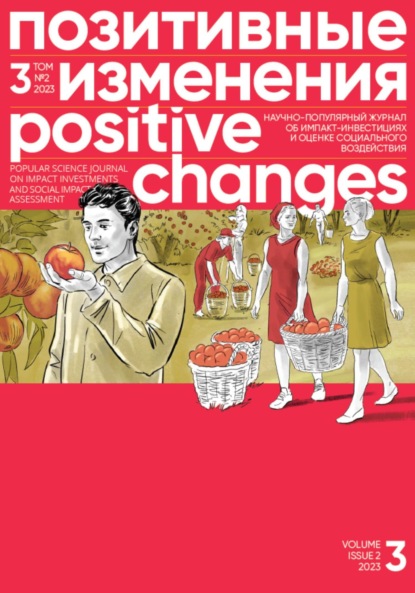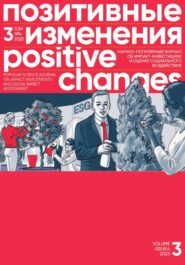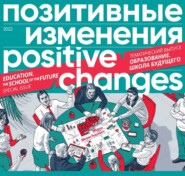По всем вопросам обращайтесь на: info@litportal.ru
(©) 2003-2024.
✖
Позитивные изменения. Том 3, № 2 (2023). Positive changes. Volume 3, Issue 2 (2023)
Настройки чтения
Размер шрифта
Высота строк
Поля
27. Чебакова, Ю. В. (2010). Психосемантический анализ гендерной идентичности. Экспериментальная психология в России: традиции и перспективы.
28. Яновский, М. И. (2010). Проблема изучения кинематографа в психологии. Психологический журнал, 31(5), 79–88.
29. Яньшин, П. В. (2006). Психосемантика цвета.
Decoding Harmony Through Algebra. Viktor Petrenko and Psychosemantics in Cinematography
In March 2023, Viktor Fedorovich Petrenko, a renowned Russian psychologist, celebrated his 75th birthday. Holding a doctoral degree in Psychological Sciences and being a Corresponding Member of the Russian Academy of Sciences, Petrenko’s name may not be familiar to everyone, particularly those outside the realm of psychology. Nevertheless, it is highly probable that his groundbreaking methods, which he spent over five decades of his life creating, researching, and applying, have influenced your scientific or practical endeavors. The sheer indispensability of psychosemantics, a field at the core of Professor Petrenko’s work, cannot be overstated when contemplating the landscape of modern science and research practices. Regarded as a trailblazer in this field, he was among the first in the country to apply factor analysis techniques to processing psychological data, paving the way for the evolution of this discipline.
Natalia Gladkikh
Leading Expert, Institute of Socio-Economic Design, National Research University Higher School of Economics
Anna Movchan
Junior Researcher, Federal Resource Center, Moscow State University of Psychology and Education
Drawing attention to his impact, it is worth noting that Viktor Petrenko’s works have garnered over 12,000 citations, according to eLIBRARY.RU statistics. The magnitude of his influence becomes apparent when considering that a Hirsch index surpassing 30 is typically associated with Nobel laureates; however, Professor Petrenko’s index stands at an impressive 37. Yet, beyond these numerical achievements lies a vibrant tapestry of intellectual contributions, far from a mere collection of dry academic texts. Instead, it encompasses a living, breathing “algebra” – the psychosemantic methodologies that meticulously unravel intricate systems of individual meanings, illuminate the factors driving effectiveness, unravel the roots of loyalty, and decode the complex interplay of images and their associated connotations. Grounded in the principles of multivariate statistics, psychosemantics empowers us to delve into the true perceptions and emotions of individuals. From examining responses to artistic works and political figures to dissecting the impact of cultural differences, gender stereotypes, and even the subtleties of advertising campaigns, psychosemantics offers answers to seemingly unanswerable questions with remarkable precision.
In this article, our aim is to provide a general overview of psychosemantics, shedding light on its origins, the circumstances that led to its creation, its diverse applications, and the vast realm of possibilities it unlocks, particularly in the domain of art and cinema. In addition to scrutinizing various publications, we have incorporated insights from a recent interview with Viktor Fedorovich Petrenko, conducted this May.
HOW IT ALL STARTED
As renowned American psychologist Michael Cole highlighted in the preface to Petrenko’s article, “Meaning as an Element of Consciousness” published in the English-language journal Psychology in Russia and Eastern Europe, “Petrenko draws upon the American technological toolkit to address traditional issues in psychology, influenced by the works of L. S. Vygotsky” (Cole, 1993). Methodologically, psychosemantics finds its roots in the pioneering works of a remarkable cohort of psychologists from the 1920s, including L. S. Vygotsky, A. N. Leontiev, and A. R. Luria. Viktor Fedorovich Petrenko, one of the early graduates from the Psychology Department of Moscow State University and a student of A. N. Leontiev, emerged as a frontrunner in the realm of experimental psychosemantics while still a student. During that time, the Department of Psychology at Moscow State University undertook a comprehensive exploration encompassing not only the study of consciousness but also the domains of child psychology and neuropsychology. However, it was within the department of “General Psychology,” helmed by A. N. Leontiev, that the profound investigation into the psychology of consciousness and perception found its most distinguished representation.
In the quest for methodologies capable of delving into the intricate nature of consciousness, V. F. Petrenko ventured into the realm of structural linguistics, drawing inspiration from the works of I. A. Melchuk, A. K. Jolkovsky and Yu. D. Apresyan, where semantic graphs were used to distill content into a language of meanings. Subsequently, the pioneering contributions of Charles Osgood and later George Kelly provided the foundation for the development of experimental psychosemantics. While these American psychologists employed similar psychosemantic frameworks, their paths remained distinct. Osgood stumbled upon this model while exploring the phenomenon of synesthesia, while Kelly utilized this apparatus to investigate the transformation of clients’ worldviews and consciousness during psychotherapy. Leveraging value assessments, factor analysis, and cluster analysis, semantic spaces were constructed to serve as portrayals of the world, unique to individual or group subjects. It is worth noting that the American authors did not use the term “psychosemantics.” It was V. F. Petrenko and A. D. Shmelev who compiled the works of Osgood, Kelly, and Miller under the umbrella of “psychosemantics,” distinguishing it from the psycholinguistics pioneered by Alexei Alexeevich Leontiev.
While Charles Osgood employed bipolar scales derived from the Dictionary of English Antonyms, V. F. Petrenko and his co-authors utilized opposing judgments as scales. For instance, the judgment scales in the study of gender stereotypes included such statements as “marrying someone from another culture,” “marrying someone I don’t love because my parents wanted so,” “striving to get higher education,” “raising a child alone,” and many more.
V. F. Petrenko was the second person in the Soviet Union to use factor analysis to assess the significance of each factor and facilitate the interpretation of each scale. This interpretation is derived from the inclusion of specific scales within the factors and the identification of the most contrasting objects within the semantic space.
The foundation for the development of experimental psychosemantics provided by Charles Osgood and George Kelly which employed similar psychosemantic frameworks.
The first large-scale study utilizing psychosemantics methods focused on Estonian and Azerbaijani samples. Discussions of ethnic differences were not customary at the time, which resulted in a six-year delay before the article could be published. During gender comparison, the data was found to be very similar between Azerbaijani women and Azerbaijani men; the same was true about Russian men and women. However, substantial differences were observed between Russians and Azerbaijanis. This suggests the presence of distinct social stereotypes and norms within each culture. Consequently, separate male and female cultures cannot be delineated, as the value systems in both cases exhibit significant proximity.
In the late 1980s, amid Gorbachev’s perestroika, the emergence of new political parties and movements prompted Viktor Petrenko an idea of constructing a semantic space for political parties to gain insights into the trajectory of unfolding events. Olga Valentinovna Mitina, a longstanding colleague and collaborator in numerous subsequent studies, provided invaluable support as his assistant and co-author.
Figure 1. Example of a semantic space depicting the dynamics of role positions during hypnotherapy in drug rehab patients, with the factors “General Well-Being” ? “Adversity” and “Orderly living” ? “Disorderly living (readiness for change)”
Methodologically, the study mirrored gender studies, albeit with political parties (a total of 28 entities) as the subjects of examination. The researchers meticulously analyzed an extensive corpus of newspapers, party programs, and speeches delivered by political leaders, extracting judgments that were subsequently transcribed into scales. Among the salient issues probed were questions that reflected the prevailing worldview of that era, such as “Can individuals possess private property?” “Should the republics maintain their own armed forces?” and “Is religious freedom essential?” In total, 212 judgments were scrutinized.
The outcomes of the study exhibited a remarkable predictive capacity, as it successfully identified the strongest factions: Democrats being the most influential, followed by the Communists, and then the National Patriots. When Hakob Pogosovich Nazaretyan, an expert in evolutionary theory, political psychology, and cultural anthropology, and a friend of Viktor Petrenko, examined the results, he made an astonishing statement: “There’s a good chance that the Soviet Union will break up.” At the time, that suggestion appeared absurd. A pilot experiment was conducted in 1990, revealing that the dominant factor was the “acceptance” or “rejection” of Communist ideology. Then, in 1991, just before the collapse of the USSR, the most influential factor became the “preservation of the Soviet Union” vs a “Federation” or “Confederation of Independent Republics.”
PRESENT-DAY APPLICATIONS
Today, psychosemantics finds extensive application in ethnopsychology, studies of the perception of art (including paintings and feature films), and color perception (Yanshin, 2006). It is also employed in political psychology (Petrenko & Mitina, 2017), gender studies (Chebakova, 2010; Dambaeva, 2017), various clinical and psychological investigations, studies on the worldview of specific social and age groups, assessment of the effectiveness of commercial and social advertising (Gladkikh, 2017; Kyshtymova, 2014; Kshenina, 2006; Teplova, 2016; Gladkikh & Vainer, 2018), and numerous other domains. A new promising area of exploration lies in finding and analyzing the methodological junctions between psychosemantics of consciousness and quantum physics (Petrenko & Suprun, 2017).
The Psychosemantic methods are also in studying the perception of political and socio-cultural issues, as they enable the identification of underlying attitudes and stereotypes that may remain concealed or hard to detect due to social undesirability (Petrenko, Gladkikh & Mitina, 2016; Gaivoronskaya, 2018). Moreover, these methods find use in investigating altered states of consciousness. For instance, V. F. Petrenko, together with V. V. Kucherenko, compared semantic spaces during hypnotherapy to observe the dynamics of changes in individuals’ worldview (Petrenko et al., 2006). It is safe to say that there are few areas of psychology left where one cannot find examples of the use of psychosemantic tools. The results obtained strongly advocate for the popularization of the method of constructing subjective semantic spaces for studying social representations.
A BRIEF OVERVIEW OF PSYCHOSEMANTICS
In linguistic dictionaries, “semantics” is defined as the meaning conveyed by a sign, be it a symbol, word, text, or utterance in the broadest sense. It is a branch of linguistics that examines the semantic significance of language units. Psychosemantics, on the other hand, is a field of psychology that investigates the structure, formation, and functioning of an individual or collective subject’s system of meanings.
At the core of psychosemantics lies the “Subjective Semantic Space,” which represents a person’s categorization structure as a mathematical field. The coordinate axes within this space correspond to the inherent grounds of categorization, as shown in Figure 1 (Petrenko, Kucherenko & Vyalba, 2006).
The semantic space serves as a research tool that allows identifying semantic relationships between objects and analyzing their structure. The construction of a semantic space involves three key steps (Petrenko, 1982):
1. In the first stage, semantic connections between objects are analyzed using such methods as associative experiments and subjective scaling. This step results in the construction of a similarity matrix that encapsulates the internal structure of the semantic space.
2. In the second stage, the similarity matrix is subjected to mathematical processing to uncover the underlying factors or clusters. This typically entails using various techniques such as factor analysis, multivariate scaling, and cluster analysis. It is important to note that mathematical processing does not generate new content but allows for the presentation of raw data in a concise and well-structured format.
3. In the third stage, the selected structures are interpreted by searching for semantic invariants that unite the objects grouped within a factor or cluster. Competent experts are involved, and reference objects are introduced to formulate hypotheses about the content of the factors.
PSYCHOSEMANTICS IN CINEMA: A CASE STUDY
The application of psychosemantics in cinema assumes a crucial role as it uncovers the genesis, structure, and functioning of individual and collective systems of meanings portrayed in cinematic images and reality. Each viewer, immersed in the events on the screen, identifies with specific characters, and different scenes evoke distinct emotions in each person. Cinemalogy highlights fundamental codes that foster free strategies and imagination to enhance humanistic values like personal worth, responsibility, cooperation, evolution, freedom, and spirituality (Strelkova, 2009; Yanovsky, 2010). Numerous studies have explored the psychosemantics of film art, including analyses of movies such as “Stalker,” “The Barber of Siberia,” “Rashomon,” and others (Petrenko et al., 2014).
To provide a clearer illustration of this approach, let us turn to V. F. Petrenko’s work, “Psychosemantic Analysis of the Feature Film The Barber of Siberia’” (Petrenko, 2005).
Experiment Procedure. After collectively watching the film, the respondents were asked to formulate bipolar constructs that contrast the characters (using G. Kelly’s Triadic Choice methods)[2 - In order to form a construct, the experiment should involve both similarities and differences among the objects (for instance, Ivanov and Petrov are brunettes, and Sidorov is not). Hence, in order to identify a construct, it is essential to establish correlations among a minimum of three objects using the method of triadic comparison, which is a modification of the scaling method. This involves considering two objects that are similar (the emergent pole) and one object that is different (the implicit pole).].
Figure 2. Semantic space depicting the relationships between characters of the feature film ‘The Barber of Siberia’ by Factor 3 and Factor 4
The experiment involved 100 students from various universities in Moscow, both males and females. As a result, the respondents formulated 1,038 constructs, averaging about 10 constructs per person.
Objects of analysis (characters): Tolstoy, Jane 1 (upon her arrival in Russia), Jane 2 (after falling in love with Tolstoy), Radlov, Mokin, Tolstoy’s Mother, McCracken, Dunyasha, Alexander III, the Grand Duke, Polievskyy, Terrorist, Sergeant, and Andrew. Considering that the film takes place on the border between Russian and American mentalities, two additional virtual role positions were introduced to highlight this mental borderland: “Russian” and “American.”
Through factor analysis, the initial character oppositions were grouped into six factors, which were interpreted as artistic constructs according to the authors’ terminology:
• Factor 1 – “Passive obedience ? Inner independence and ability to act and fight”
• Factor 2 – “Inherent Dignity ? Unprincipled”
• Factor 3 – “Unbalanced Impulsiveness ? Common Sense”
• Factor 4 – “Proud Superiority ? Pleading Dependency”
• Factor 5 – “Openness to Diversity ? Inner Limitation”
• Factor 6 – “Devotion to the idea ? Immersion in everyday life”
These factors were used to construct the characters’ semantic spaces, as shown in Figure 2.
In Factor 3, Tolstoy emerges as the most prominent character, significantly differentiated from the others. Additionally, characters such as Tolstoy’s Mother, the Terrorist, and the Grand Duke exhibit traits that prevent them from asserting themselves and instead lead them to be immersed in an illusory world. Conversely, characters like Mokin, Dunyasha, Jane 1, Jane 2, and Andrew embody balanced practicality and common sense (Fig. 2).
On the other hand, Factor 4 highlights the most polar positions held by characters such as Dunyasha, Tolstoy’s Mother, McCracken, and the Terrorist, who possess lower social status. They contrast with characters like Alexander III, Radlov, Polievskyy, and the Grand Duke, who wield power and experience a sense of superiority over others.
By analyzing the semantic space, we gain valuable insights into the underlying meanings and interactions among the characters in “The Barber of Siberia,” shedding light on their roles and dynamics within the film. By identifying the main lines of opposition among the characters, the researchers formulated a system of constructs for the film. To gain a more precise understanding of how viewers perceive the personalities of the characters, an additional psychosemantic technique called “motive attribution” was employed (Petrenko, 2014).














